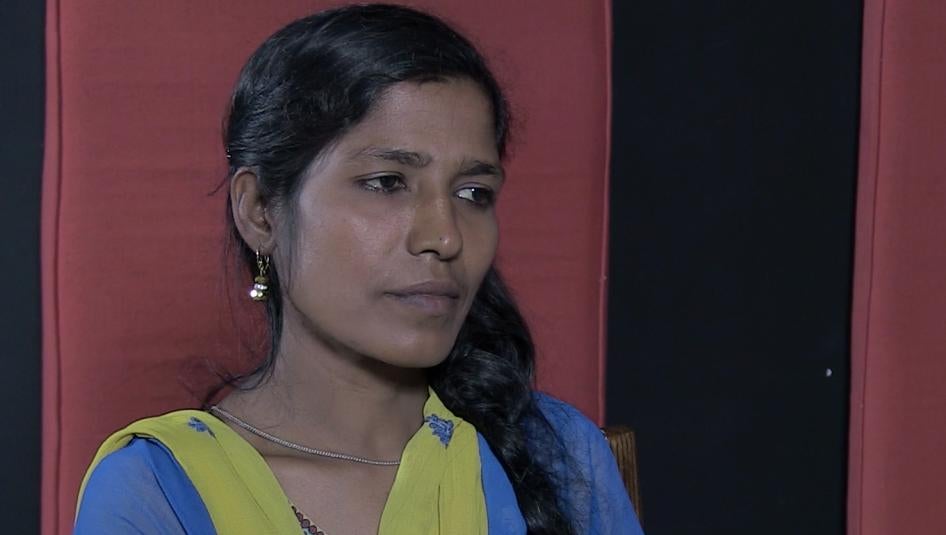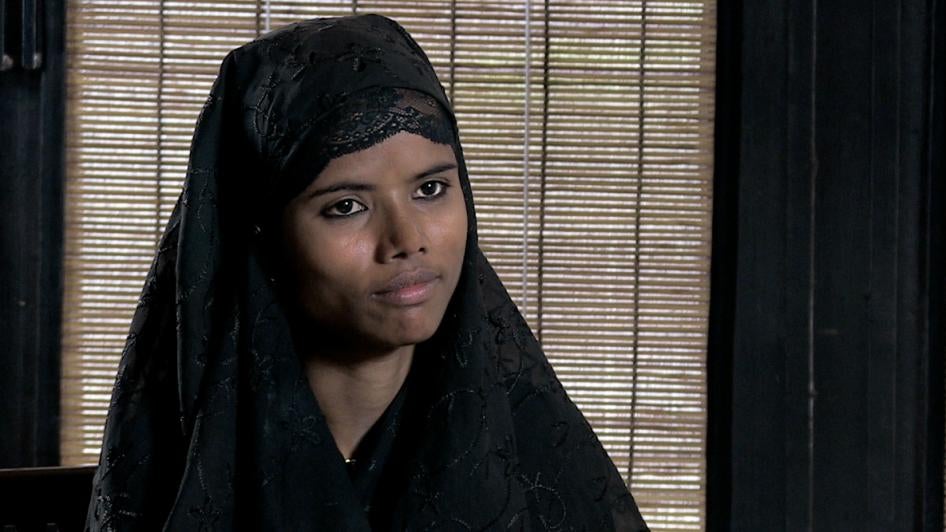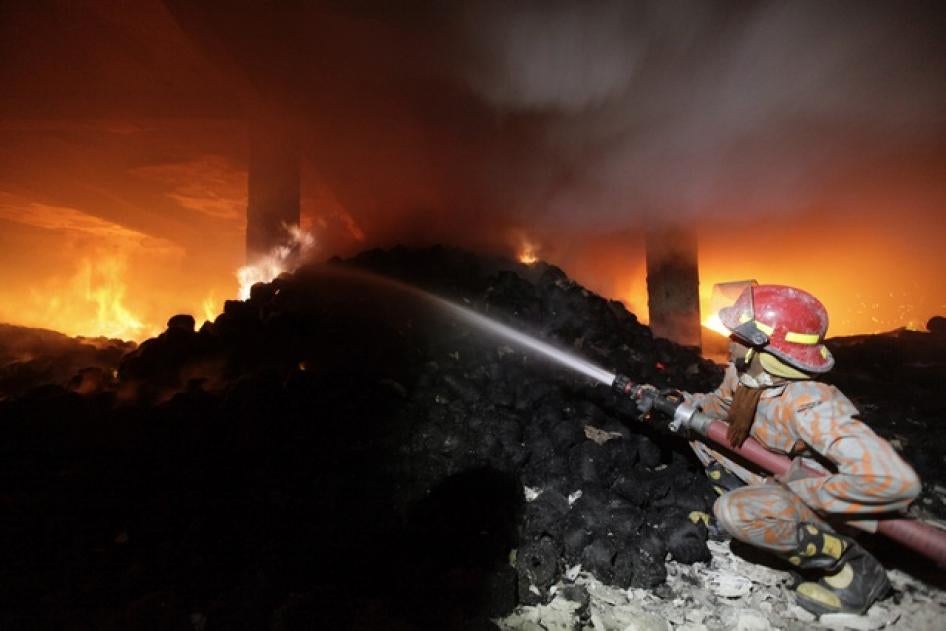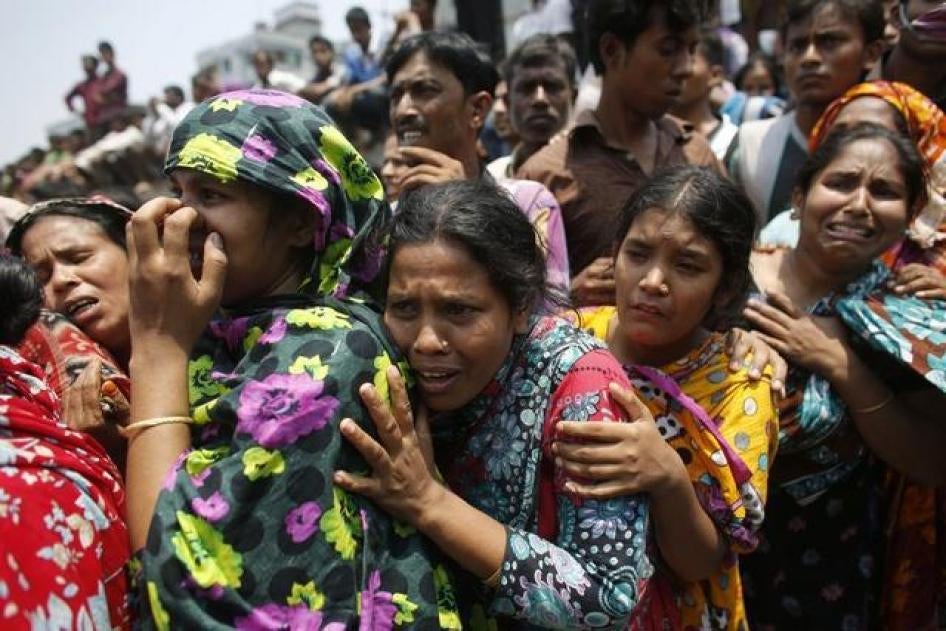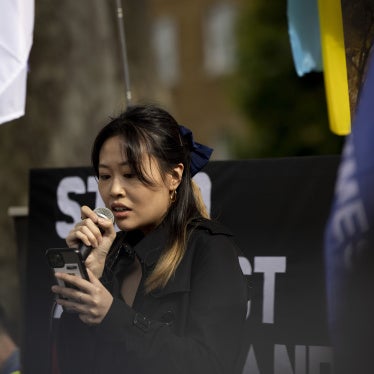Roksana and Beauty lingered outside that fateful morning two years ago – neither wanted to go inside to start turning out jeans and shirts in the factories housed in Rana Plaza the day after they had been evacuated because of cracks in the building. But their line managers pushed and cajoled until both women went to their stations at two of the five ready-made garment businesses inside.
“I was scared,” Beauty recalled in a video interview with Human Rights Watch in Dhaka. “I didn’t feel like going inside, my heart was pounding.” She said she couldn’t work properly that morning because she was crying, prompting verbal abuse from a manager.
On another floor, Roksana was anxious, unable to settle down to her work, but “our tasks kept piling up. The bosses said they wouldn’t let us leave until we had finished the task, and said we wouldn’t get the day’s salary plus the two hours of overtime if we left without finishing the order. We get a pretty small salary. We can’t risk losing even a tiny part of it.”
But on that day, April 24, 2013, Rana Plaza, an eight-story building in Savar, a suburb of the Bangladeshi capital, Dhaka, collapsed, killing more than 1,100 workers and injuring 2,000 more. Fewer than 140 of Bangladesh’s 4,500+ garment factories were unionized at that time – there was no mechanism for workers at factories in Rana Plaza to negotiate with managers and owners over pay and conditions, let alone refuse to enter the workplace for fear it might collapse.
Beauty remembers that the power went out that morning; a mechanic started up the generator: “The building trembled heavily and the pillars beside me started to crumble. Rubble from the pillar hit me on my leg,” she explained in her video interview. “I probably would not have survived had I not been hit by the rubble. This was the sign. I screamed and moved towards the door. “
As Beauty described it, there were three exits from the eight-floor structure but only one was usable, blocked by an internal gate that the guard had closed. “I punched the watchman hard so I could get through the gate… I looked back and saw the factory collapsing.”
On her floor, Roksana heard a loud noise and tried to run, but, “The building collapsed in the blink of an eye.” Trapped in the rubble, Roksana fainted and woke up hours later. She found her cellphone, but couldn’t call out. “There was a girl’s dead body underneath me… the blood from her ears and nose was all over my back and face. It soaked my back completely,” she said. Three young men were also trapped around her, and a metal rod had pierced her knee. “I couldn’t feel any pain, I felt like I had been sleeping. I could not hear anything. I kept fainting and coming round.” She wept as she recalled the scene. “Waiting for the desired death kept me alive for two nights in that captivity.”
On the third day, rescuers managed to drill a hole, pass down a metal pole and guide survivors to safety. Roksana struggled to join other workers crawling out, grabbing the leg of one man who knelt on her chest as he made his way towards the light. He couldn’t help to free her but the metal rod in her left knee dislodged and she was able to drag herself out.
The ready-made garment industry is worth about $24billion a year to Bangladesh, employing around 4 million workers, 80 percent of them women. It’s vital to the economy, supporting perhaps 20 million Bangladeshis.
The Rana Plaza disaster was a wake-up call to the industry. “It was a big lesson for us,” Mohammad Shahidullah Azim, vice-president of the Bangladesh Garment Manufacturers and Exporters Association (BGMEA), which represents many factory owners, told Human Rights Watch. “Now everybody understands that we have to make the safety of the work first, then we have to go for other things. It’s very important for us.”
Since that ghastly day, health and safety standards have improved in the industry –the Accord on Fire and Building Safety is a legally binding agreement between more than 175 mostly European brands and trade unions designed to enable a safe and healthy working environment; 26 North American retailers, including The Gap, Macy’s and Wal-Mart, set up a similar inspection agreement. But although the government has taken steps to improve labor standards – for example, increasing the number of factor inspectors and registering more unions – there is still a long way to go, a Human Rights Watch report found.
Workers still report that they are paid late, denied overtime or sometimes not paid at all, and deprived of paid holidays and maternity leave, though these are guaranteed under Bangladeshi law. Even after the Rana Plaza disaster, fewer than 10 percent of garment factories are unionized.
A typical shift can last 11 to 14 hours a day, 26 days a month, for a minimum wage of $68. “Verbal and physical abuse also exist in the factories,” said Kalpona Akter, executive director of the Bangladesh Center for Workers Solidarity. “And more important is when the worker tries to raise their voice and organize unions in their respective factories, they face harassment and intimidation.”
Although many retailers pay into a Rana Plaza compensation fund, survivors say they haven’t received adequate compensation. As of March, only $21 million of the $30 million needed to compensate survivors had been paid or pledged to the fund, with the British company Primark giving $14 million. Yet 15 retailers whose labels were found in the Rana Plaza rubble have yet to contribute.
Roksana’s medical bills were paid for her, but she is struggling to survive because her injuries make it almost impossible to work. “I cannot keep sitting or standing for too long… and I can’t lift any weight,” she said, adding that she had received compensation of 95,000 taka (about $1,230) via bKash, a mobile phone payment system. “That money has almost gone and I’m still not well,” she said. “The damage done has left me worthless… I dreamed of making my own home, but everything is shattered.”
Beauty said she received 45,000 taka ($584) via bKash and tried repeatedly to register for more assistance, without success. She’s working in a smaller factory: “I’m in dire need of money… to pay for my daughter’s education.” And the psychological hurt persists: “I now live in a mud-built home. I’m afraid it will collapse if I find even a small crack in the wall. Even noise on the street freaks me out – I leave the factory if I hear a trivial sound. Fear is deeply rooted in me.”
